The U.S. mining industry may face challenges in the short term, but there are still opportunities for growth and adaptation within the global mining ecosystem.
Author: Jaran Mellerud
Translated by: Deep Tide TechFlow
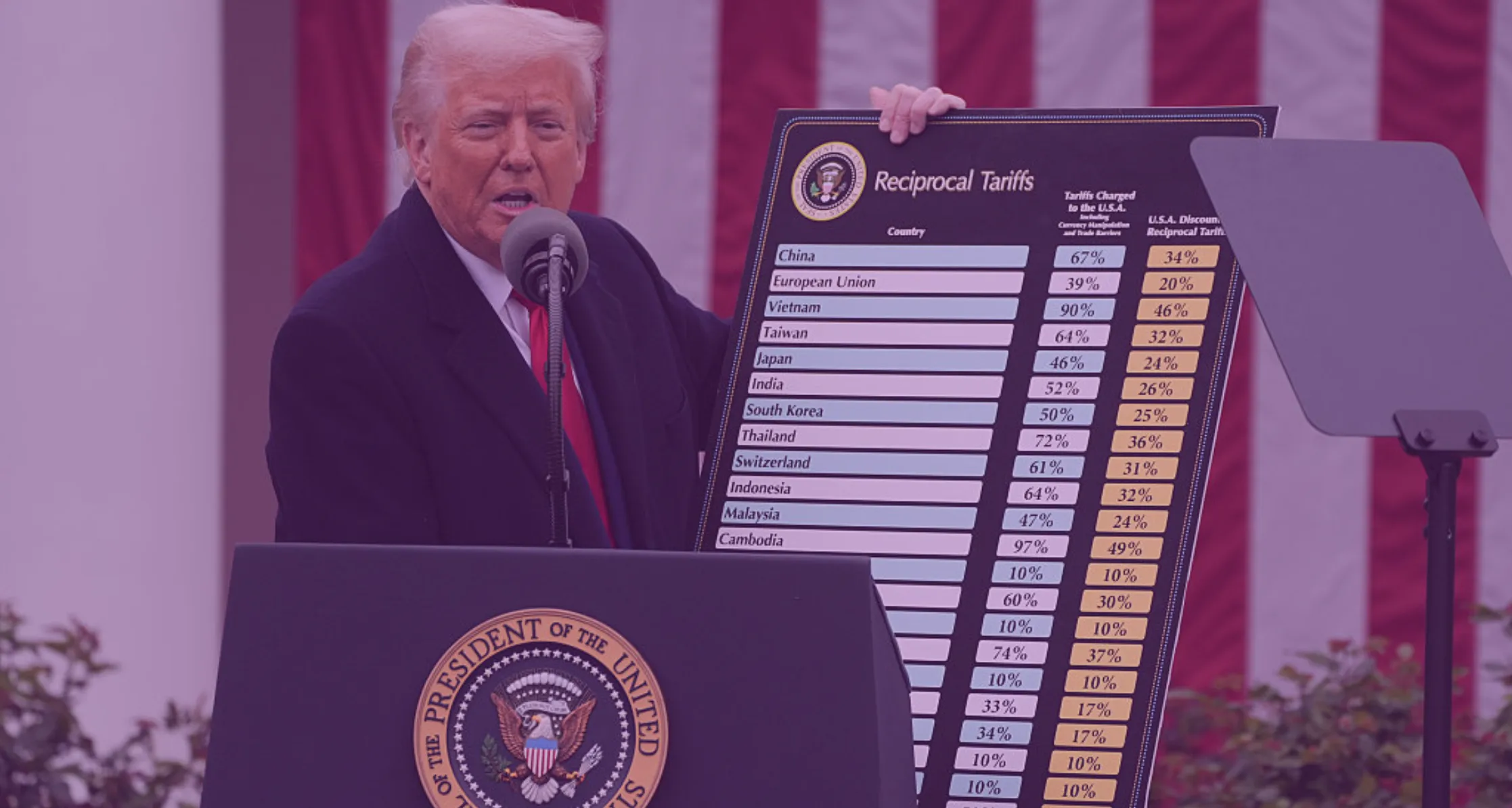
Summary: U.S. mining machines will become more expensive, and market share will decline
Trump's tariff policy will have a significant impact on the Bitcoin mining industry. Below is an analysis of how this policy affects the industry.
On April 2, Trump announced a comprehensive new tariff on imported goods aimed at strengthening the U.S. trade balance. Southeast Asia is hit the hardest, which has far-reaching effects on the Bitcoin mining machine supply chain. This region is home to most mining machine manufacturers, including major producers like Bitmain, MicroBT, and Canaan.
Moreover, since the U.S. accounts for 36% of global hash power, these tariffs could severely impact miners' economic benefits, hardware prices both domestically and internationally, and the global distribution of hash power.
Before delving into the multifaceted impacts of these tariffs on the Bitcoin mining industry, let’s briefly explain how tariffs work.
How Do Tariffs Work?
Tariffs are taxes imposed by the government on imported goods, typically aimed at protecting domestic industries by raising the prices of foreign products. When tariffs are implemented, importers must pay a certain percentage of the declared value of the goods to customs upon entry.
For example, if a U.S. company imports electronic products worth $1,000 from China, and the tariff rate is 54%, the importer must pay an additional $540 in tariffs, bringing the total import cost to $1,540. This increased cost is usually passed on to consumers or reduces the profit margin for importers.
History of Tariffs: The U.S.-China Trade War and Its Ripple Effects
Bitcoin mining is a global industry, with the U.S. being a significant player. The trade war and the tariffs it triggered have already impacted the industry. However, historically, companies within the industry have found ways to circumvent these tariffs. In the following sections, we will explore how tariffs have historically affected the Bitcoin mining supply chain and what strategies companies have employed to avoid these tariffs.
In 2018, the U.S. government imposed a 25% tariff on a range of Chinese goods, including electronics, as part of the U.S.-China trade war.
In response, companies like Bitmain began looking for ways to circumvent these high tariffs. They shifted production from mainland China to Southeast Asian countries such as Indonesia, Thailand, and Malaysia, where goods exported to the U.S. are either tariff-free or subject to lower tariffs—typically between 1% and 3% for electronics.
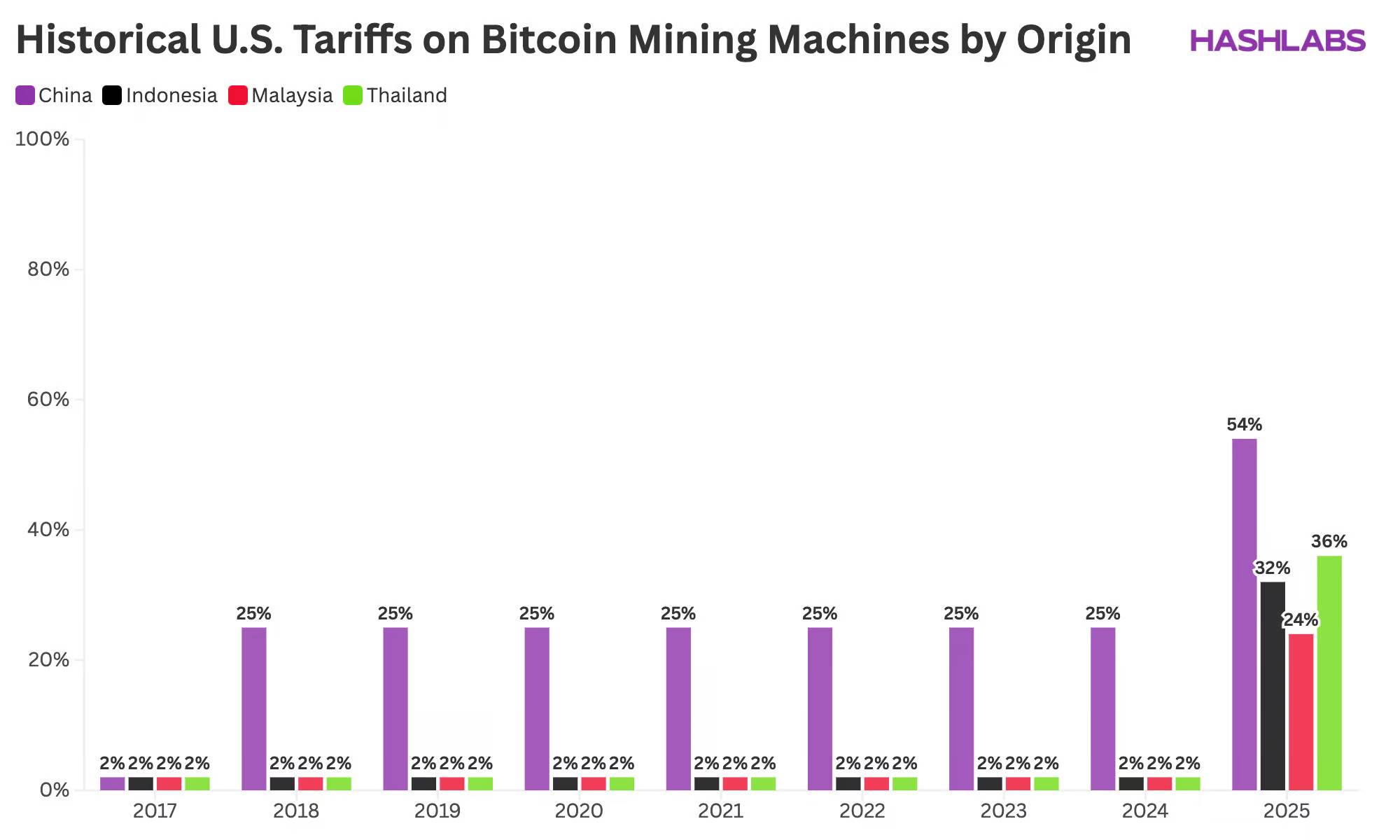
This strategy remained effective until earlier this month when Trump raised tariffs on goods imported from Indonesia, Malaysia, and Thailand to 32%, 24%, and 36%, respectively. As a result, companies like Bitmain and MicroBT can no longer completely avoid these high tariffs, which were initially only targeted at goods imported from China.
In the following sections, we will explain in detail how these newly implemented tariffs will affect the Bitcoin mining industry.
Prices of Mining Machines in the U.S. Will Rise Significantly
The most direct and obvious impact of the tariffs is that the prices of mining machines in the U.S. will rise significantly.
As Ethan Vera pointed out on "The Mining Pod": “…any company operating in the U.S. that wishes to purchase mining machines will need to pay an additional 22% to 36% for these machines.” This aligns with our data.
However, the 22% price increase only applies to imported mining machines. Currently, there is still a large inventory of mining machines within the U.S. According to Bitmars' pricing data, the price of mining machines in the U.S. currently has a price difference of 13% to 25% compared to those in Hong Kong. As U.S. inventory decreases, this price difference may narrow to 22%, plus a small amount for shipping costs.
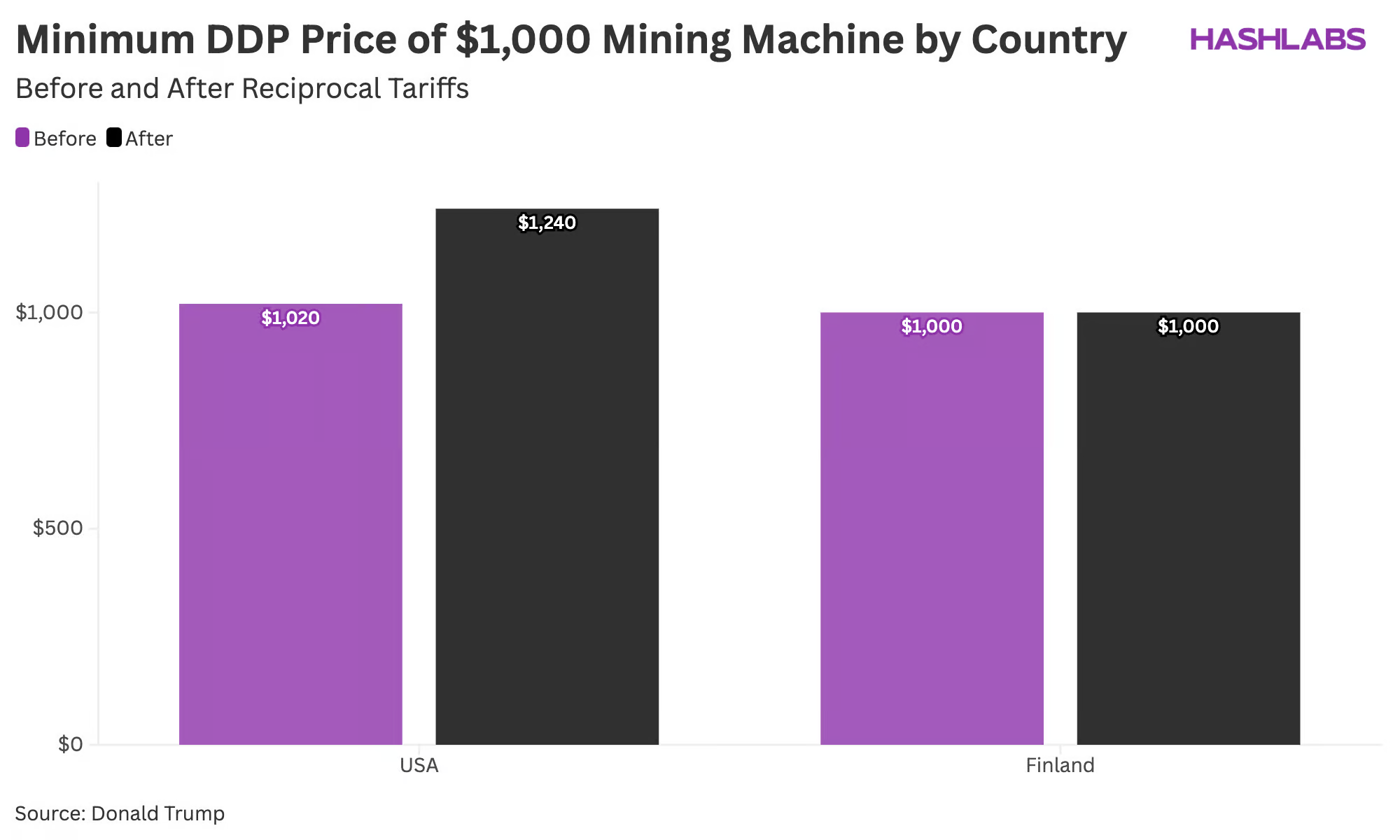
The above image shows the final cost of importing a $1,000 Bitcoin mining device to the U.S. and Finland before and after the introduction of reciprocal tariffs. Finland, like most other countries, has no tariffs on electronics imported from Asia—we use this country as an example because we mine there.
As shown in the figure, the initial cost of importing mining machines to the U.S. is slightly higher due to about a 2% tariff. However, after the introduction of the new tariffs, the minimum cost of a $1,000 mining machine in the U.S. rises to $1,240. This is a significant increase. Meanwhile, in Finland and most other countries, the cost of a $1,000 mining machine remains unchanged due to the absence of tariffs.
In an industry like Bitcoin mining, which is extremely sensitive to costs, a 22% increase in mining machine prices could make operations financially unsustainable. In the subsequent sections of this article, we will explore how these changes will affect mining profitability in the U.S. compared to other regions.
Mining Machines Outside the U.S. May Become Cheaper
As prices for mining machines in the U.S. rise, prices in other parts of the world may trend in the opposite direction.
Demand for mining machines shipped to the U.S. is expected to drop significantly, potentially approaching zero. Given that the U.S. has long been the dominant player in the ASIC (Application-Specific Integrated Circuit) market, accounting for nearly 40% of global hash power, a sharp decline in U.S. purchases will lead to a significant reduction in global demand.
With reduced demand from U.S. miners, manufacturers will face excess inventory that was originally planned for the U.S. market. To clear this inventory, they may need to lower prices to attract buyers from other regions.
While it is difficult to predict exactly how much mining machine prices will decline—since mining profitability also affects prices—we can conclude based on basic economic principles that a decrease in demand for an asset typically leads to a decrease in its price.
This price decline will make it easier for miners outside the U.S. to continue expanding, which may also lead to the decline in the U.S. share of global hash power that we will discuss next.
The U.S. Share of the Global Bitcoin Mining Industry Will Decline
Since China banned Bitcoin mining in 2021, the U.S. has been the dominant force in Bitcoin mining. According to data from Hashrate Index, the U.S. currently accounts for 36% of global hash power.
Like any business activity, the core of Bitcoin mining lies in balancing risk and reward. Over the past four years, the U.S. has attracted a significant amount of mining investment, as it is seen as one of the lowest-risk environments in the world, with political stability, abundant energy, and a liberalized electricity market. Additionally, miners have so far avoided major import tariffs, which has helped them control capital expenditures. These factors together create an unparalleled risk-reward balance.
To understand how the new tariffs will reshape the U.S. share of global mining, we will first analyze it from the perspective of returns.
The following figure shows the expected payback period for deploying an Antminer S21+ in the U.S. versus a country unaffected by tariffs. As the data indicates, paying an additional 24% for the same mining machine in the U.S. will significantly extend the payback period—this undermines the core economic rationale for mining in the U.S.
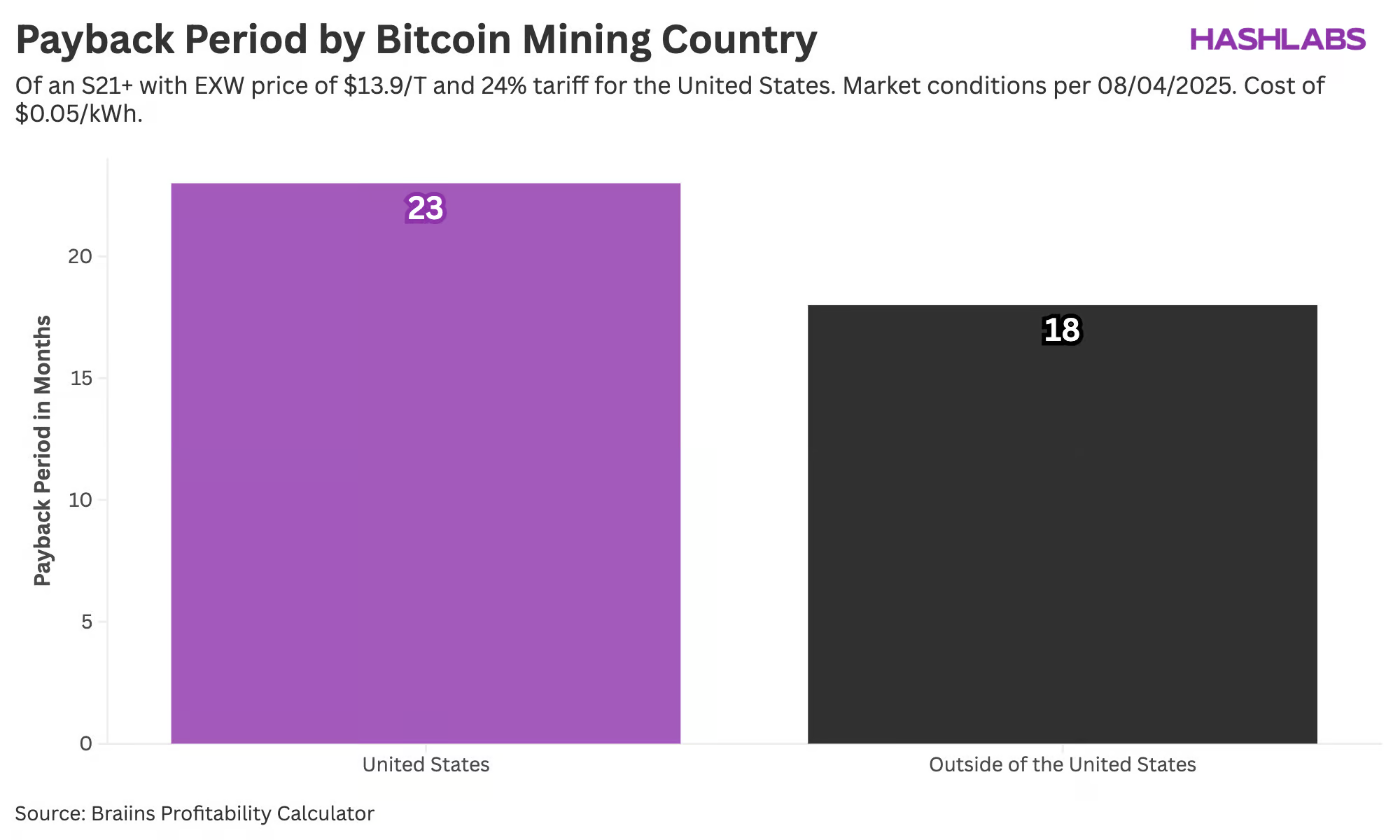
In addition to higher mining machine costs, the risk aspect has also been impacted. Many U.S. miners felt reassured when Trump regained power, anticipating a stable regulatory environment. But they are now experiencing the other side of his unpredictable policies. Even if these tariffs are lifted in a few months, the damage has been done—the confidence in long-term planning has been shaken. Few will be willing to make significant investments when key variables can change overnight.
In summary, the once unparalleled risk-reward balance of Bitcoin mining in the U.S. has significantly deteriorated. This change may lead to a gradual decline in the U.S. share of the global mining industry relative to other countries.
Of course, existing mining machines that have already been imported into the U.S. will not be affected—miners have no reason to shut them down. But the path to expansion has now become steep and fraught with uncertainty.
Meanwhile, miners in tax-free jurisdictions will continue to scale up, solidifying their competitive advantage. Therefore, it is expected that the U.S. share of global hash power will decline—not because miners are exiting, but because they are no longer growing.
From a broader perspective, this may lead to a more diverse geographical distribution of Bitcoin mining than ever before. While the U.S. will still be a major player, its dominance will weaken, and the global distribution of hash power will become more balanced. This aligns with the predictions of Braiins' Kristian Csepcar and Bitmars' Summer Meng.
Network Hash Power Growth Will Slow
In the previous section, we explained how the new tariffs will lead to a decline in the U.S. share of the global Bitcoin mining industry. Given the U.S.'s significant role in global hash power, its slowdown—or even complete halt—will inevitably lead to an overall deceleration in global hash power growth.
According to Hashrate Index data, as of the second quarter of 2025, the U.S. will account for about 36% of global hash power. In contrast, CBECI data shows that in January 2022, the U.S. share of hash power was about 38%. This indicates that over the past three years, the growth rate of the U.S. mining industry has been roughly on par with the rest of the world.
Assuming this growth trajectory would have continued, the U.S. would contribute about 36% of future global hash power growth. Therefore, if the U.S. mining industry stagnates due to the impact of tariffs, it could lead to a reduction in the global hash power growth rate of up to 36%.
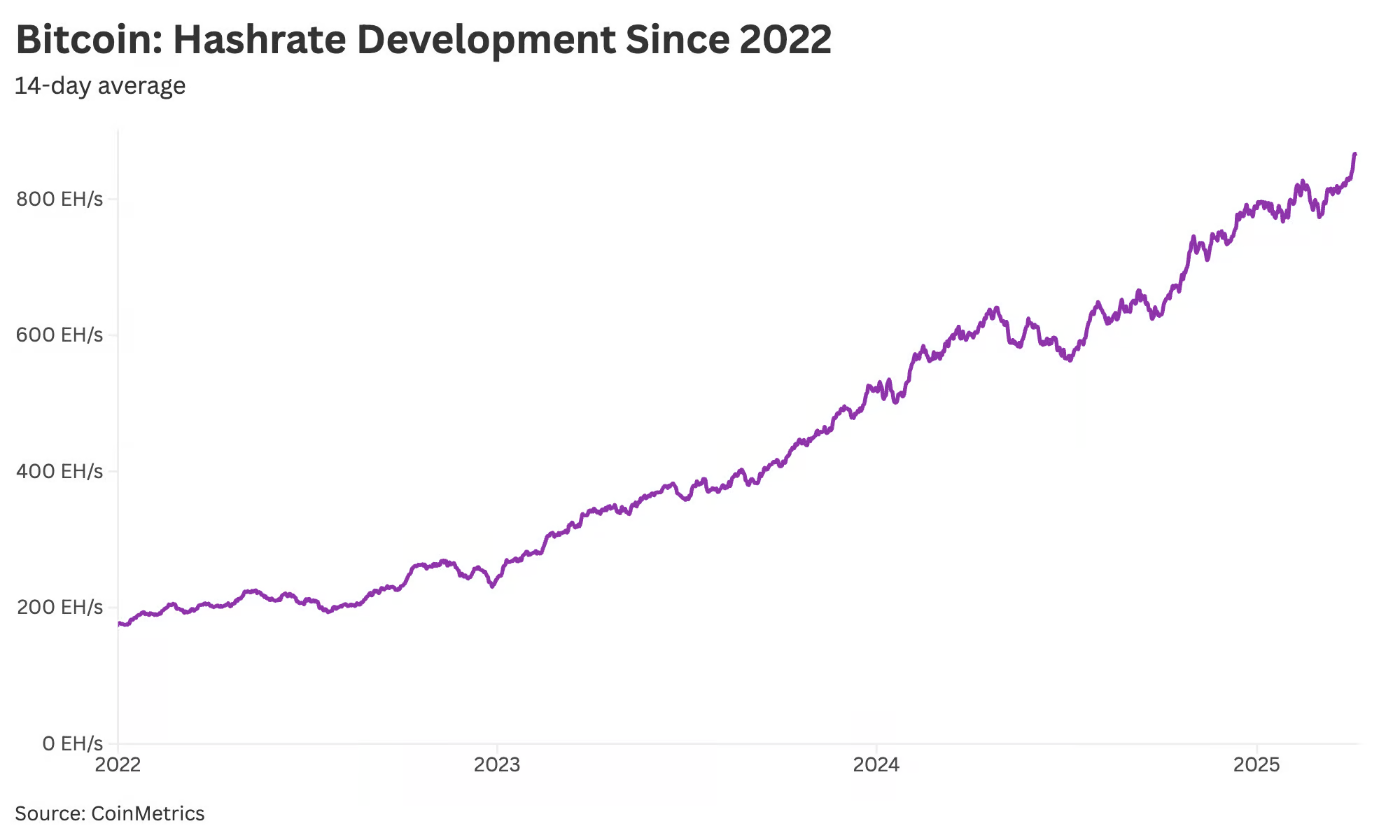
However, the likelihood of the U.S. mining industry completely halting growth is extremely low. As we will explain in the next section, these tariffs may be temporary, and there may be ways to circumvent them in the future. Therefore, a more realistic expectation is that the U.S. mining industry will continue to expand, but at a much slower pace than before. The assumption of a 36% reduction in global hash power growth should be viewed as an absolute upper limit—the actual impact may be somewhat lower.
In the long run, if U.S. growth slows or stagnates, miners in other countries may accelerate their expansion to gradually fill this gap.
Nevertheless, in the short to medium term—over the next year or two—we may see global hash power growth slow more than previously anticipated. In an industry where slowing hash power growth means higher revenues, this will be a welcome development for miners worldwide.
Is This Temporary or Permanent?
So far, this article has taken a rather pessimistic view of how these tariffs will affect the U.S. Bitcoin mining industry—this is reasonable, considering the immediate and severe impacts they may bring. However, the situation is more complex, and there are some important questions worth exploring.
In the following sections, we will address these questions and assess how the long-term prospects of the U.S. mining industry can respond to the current challenges.
Will Trump revoke the tariffs a few months after their implementation?
It is entirely possible—especially considering the unpredictability and reactiveness of Trump's policy-making style. If the tariffs are revoked, U.S. miners will be able to import mining machines at competitive prices again, alleviating many of the immediate pressures they face.
However, the damage to long-term investor confidence may have already been done. Even if the tariffs are canceled, the fact that they were suddenly introduced makes large-scale, long-term investments in the U.S. mining industry more difficult. In a capital-intensive industry like Bitcoin mining, policy stability is crucial—and that is currently in short supply.
Can mining machine manufacturers circumvent tariffs by importing chips from Taiwan and assembling machines in the U.S.?
Mining machine manufacturers may indeed be able to circumvent tariffs by importing chips from Taiwan and assembling machines locally in the U.S. According to official statements from the White House, semiconductors are not subject to reciprocal tariffs. This means that chips can be imported into the U.S. duty-free. However, producing mining machines locally still requires other components, many of which have become more expensive due to tariffs, leading to overall inflation in the U.S. economy.
Currently, manufacturers like MicroBT have established assembly lines in the U.S., but Bitmain has not yet followed suit. Even with MicroBT's assembly capabilities, its production capacity will be far from sufficient to meet U.S. demand for mining machines in the next 1-2 years.
Therefore, while this option is technically feasible, it does not address the immediate issues faced by U.S. miners. However, in the long run, we expect more mining machine assembly to gradually shift to the U.S. as manufacturers adapt to the new tariff environment and expand local production capabilities. This shift may help reduce reliance on international imports and mitigate the impact of tariffs over time.
Is it realistic to establish a complete Bitcoin mining hardware supply chain in the U.S. from chip manufacturing to final assembly?
Establishing a complete Bitcoin mining hardware supply chain in the U.S. from chip manufacturing to final assembly is a complex challenge, despite strong pushes from both the Bitcoin mining industry and political leaders for localizing chip production. Currently, the most advanced chips used in Bitcoin mining are produced in Taiwan and South Korea, regions with decades of expertise and finely tuned supply chains. The U.S. reliance on critical components from Asian countries poses a significant geopolitical risk, not just for the Bitcoin mining industry but for the entire high-tech sector.
While localizing mining machine assembly in the U.S. is feasible, the continued reliance on imported chips is a major obstacle. Companies like Bitmain, MicroBT, and Canaan can establish assembly lines in the U.S., and new entrants like Auradine are also eyeing this market. However, without locally produced cutting-edge chips, these manufacturers will still depend on imports for the foreseeable future.
Kristian Csepcsar from Braiins further emphasizes this challenge, stating, “Chip foundries have established manufacturing facilities in the U.S., but they start from high nanometer levels. Cultivating talent and expertise to shift to lower nanometer levels takes years. This process is gradual—companies start with high nanometer chips to ensure investment profitability before striving to expand into more advanced technologies. Even if the U.S. moves forward, establishing a fully localized Bitcoin mining hardware supply chain is nearly impossible, and the costs will be very high. The real question is whether it is still cheaper to manufacture in China and pay tariffs if demand is high. After all, launching end-to-end manufacturing in the U.S. takes time and significant investment, just like Bitmain's recent attempts to establish assembly lines in China—though there hasn't been much news afterward.”
In short, while the U.S. has significant potential in assembly and chip manufacturing, a fully localized Bitcoin mining hardware supply chain remains a long-term goal rather than a short-term reality. The costs, time, and complexity of this transition make the likelihood of achieving it on a large scale in the coming years quite low.
Conclusion
In summary, the newly implemented tariffs on imported goods will significantly impact the U.S. Bitcoin mining industry—leading to rising hardware prices, a decline in U.S. market share, and a slowdown in global hash power growth—but the long-term effects are more complex.
As the situation evolves, miners and industry stakeholders need to closely monitor the political and economic landscape to respond to potential tariff and policy changes. The U.S. mining industry may face challenges in the short term, but there are still opportunities for growth and adaptation within the global mining ecosystem.
免责声明:本文章仅代表作者个人观点,不代表本平台的立场和观点。本文章仅供信息分享,不构成对任何人的任何投资建议。用户与作者之间的任何争议,与本平台无关。如网页中刊载的文章或图片涉及侵权,请提供相关的权利证明和身份证明发送邮件到support@aicoin.com,本平台相关工作人员将会进行核查。




